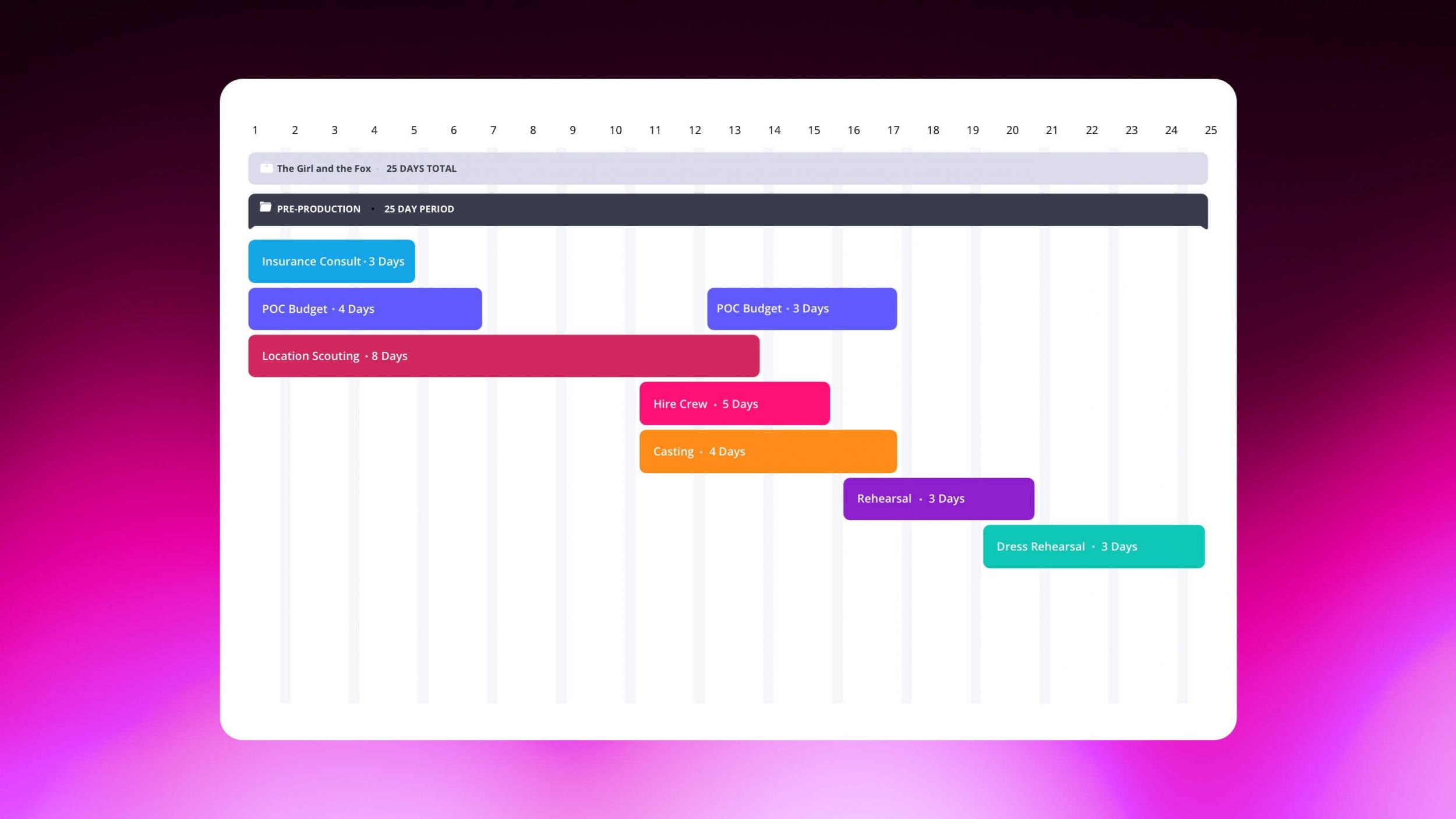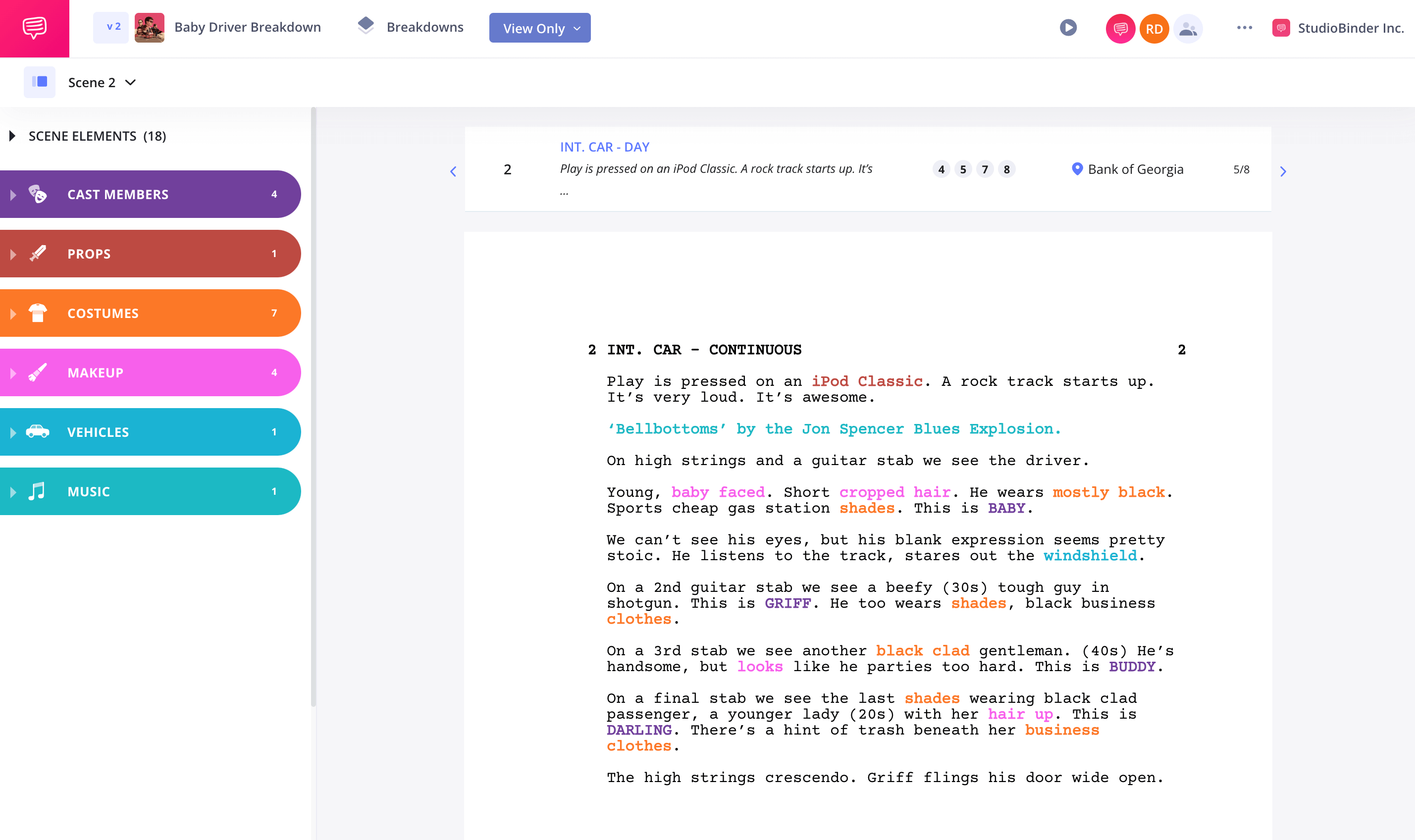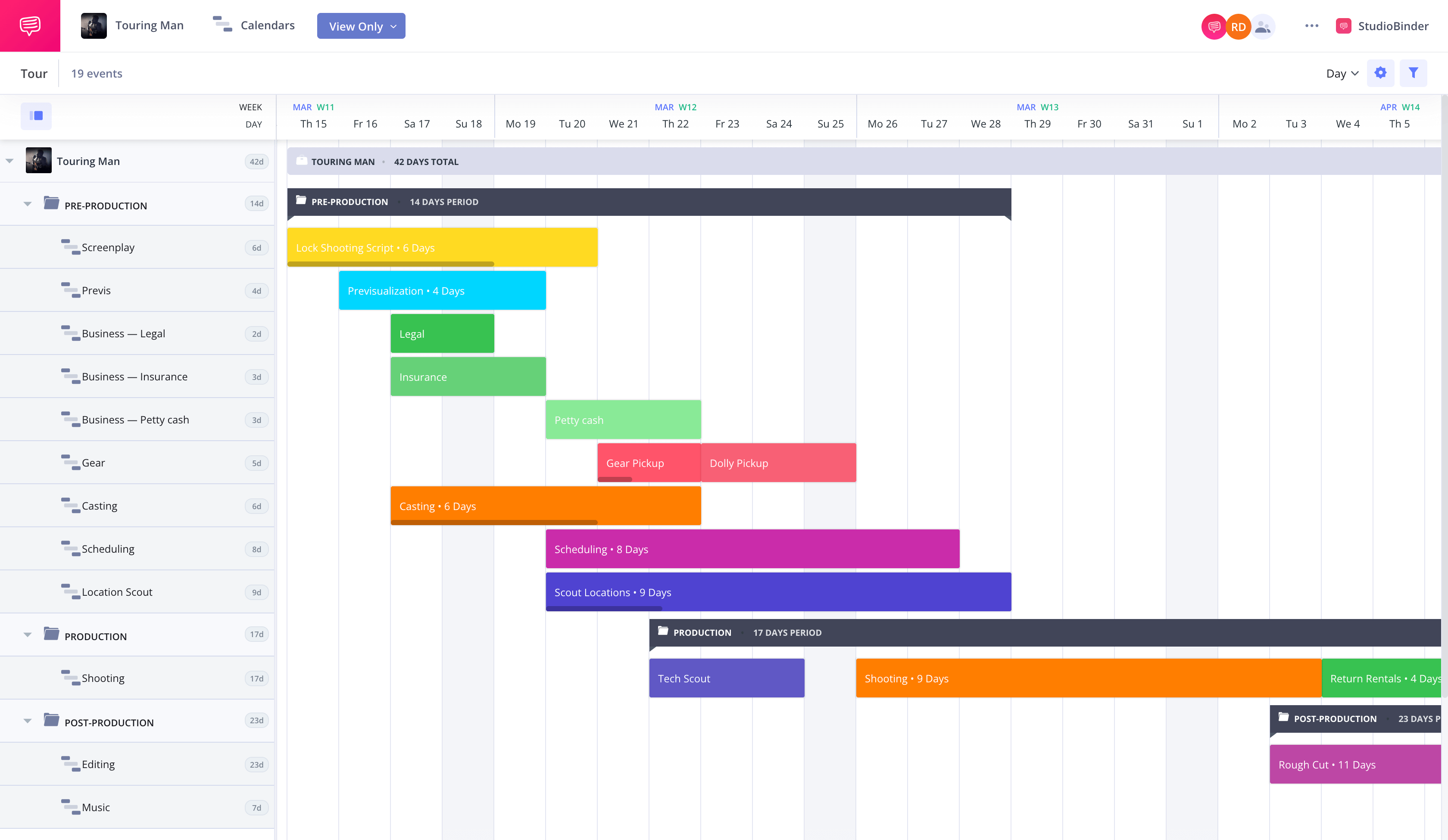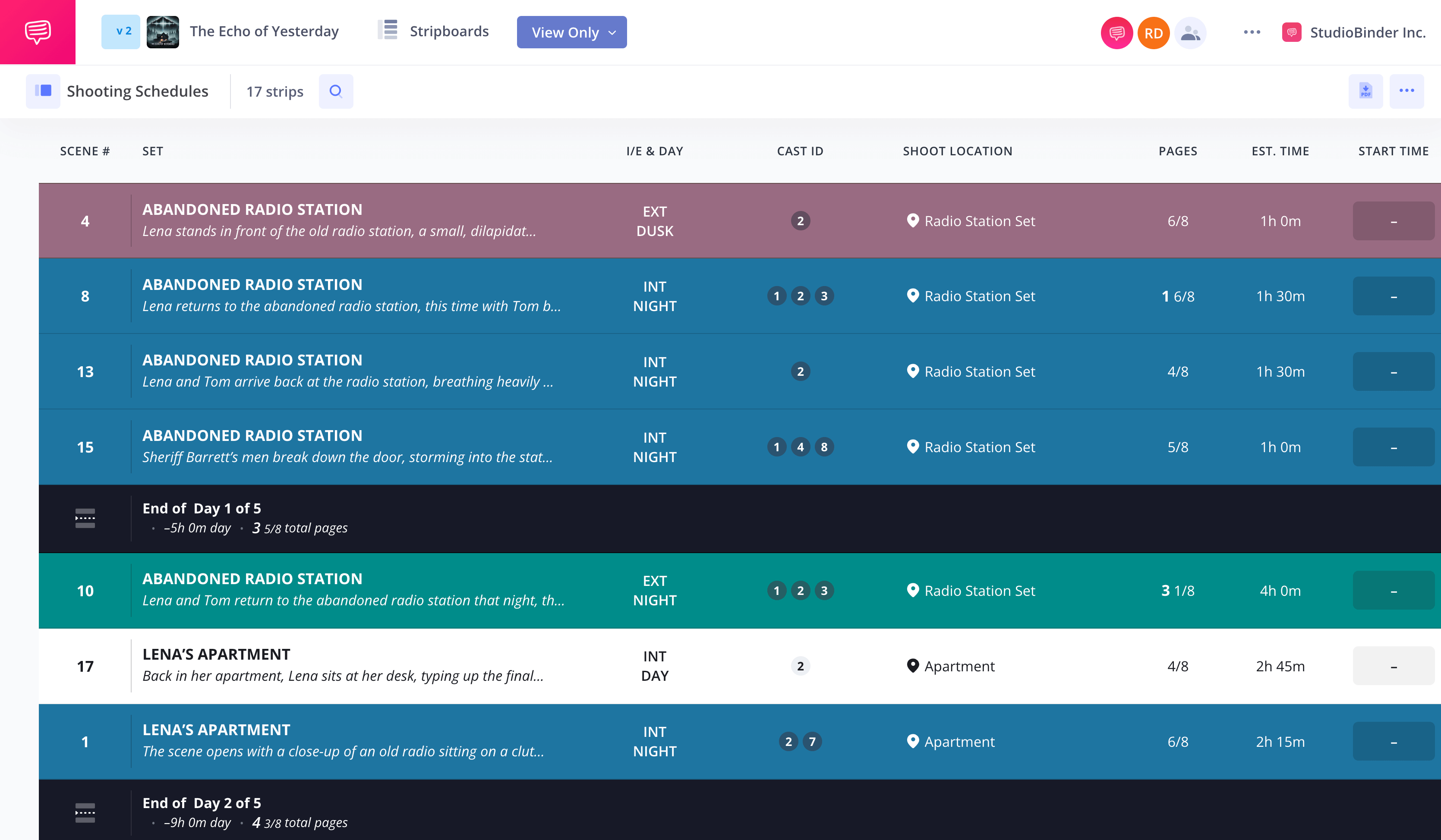A production calendar is essential for keeping projects on track, whether you’re working on a feature film, a corporate video, or a social media campaign. Without a structured production schedule, deadlines can slip, budgets can spiral, and projects may suffer from inefficiencies.
So, what is a production calendar? It’s a detailed roadmap that outlines every phase of production—from pre-production planning to final delivery. In this guide, we’ll walk you through how to make a production calendar, covering essential steps for optimizing production scheduling and ensuring an efficient production workflow.
How to Make a Production Calendar in StudioBinder
The Ultimate Guide to an Effective Production Calendar
Script breakdown & production timeline
Whether you’re producing a film, a commercial, or an online video, the first step in your production scheduling process is a preliminary breakdown. This step is crucial for developing an accurate production timeline that accounts for all necessary elements. Once a script has been green-lit for film production, the first step is carefully breaking down your script into element categories.
StudioBinder gives you the tools to break down your script into organized lists—actors, props, locations, and more. It streamlines production planning, saves time, and keeps your project on track. Want to see it in action? Check out the example below.
StudioBinder Script Breakdown & Film Scheduling Software
You’ll want a list of your actors, extras, props, and locations, to name just a few of the many production elements. It’s a pain to fill out breakdown sheets by hand, but if you’re using film production management software like StudioBinder, you can easily tag your script and let the software bucket your elements into their proper lists.
While you will already have an idea of the departments you need to contact in the pre production process, your first script breakdown will give you a sense of scale as well as a preliminary budget.
For instance, you may already know you need make-up, but a script breakdown could reveal that you need to show a flesh wound, calling for a higher budget and specialized professionals. After completing a breakdown, you’re ready to dive into pre-production using a tool like StudioBinder to build out your production calendar. Check out the example below to see how it works.
StudioBinder Production Calendar Software & Pre-Production Calendar Example
Related Posts
Pre-Production & Production Schedule Format
Budgeting & production scheduling
You should always have an idea of your film budget. When you make your preliminary breakdown, there’s usually a budget attached to that as well.
To optimize production scheduling, your finalized budget will change throughout the pre-production process as you learn how much it will cost for stunts, special effects, and all the other production elements. A long production calendar can tack on additional dollars to an existing budget.
Location scouting is that part of the pre production process where you’ll send out members of your team to secure the places you’ll shoot.
Have a location scout checklist handy before you send your team out, and make sure there’s always communication with the location manager. It’s also at this stage that you’ll determine what can be shot on a soundstage and what sets need to be built.
Just make sure you get all the approved signatures before you secure a location.
The Pre-Production Process
Optimizing the production schedule
You’ll need to hire a storyboard artist (and some concept artists couldn’t hurt either) to storyboard out difficult to intricate sequences.
If you’re working on an explainer video or TV commercial, you may want to consider storyboarding the entire thing. With lots of storyboard software out there, it's easier than ever.
In StudioBinder, you can create storyboards directly from your shot list. And it's free to start.
This is the time when your DP and director get together and talk about how they want to shoot everything. It’s a matter of going scene by scene and adding shots. Your shot lists will determine what kind of cameras you’ll need for the shoot, as well as, the crew you’ll need. You can use a free shot list template.
Your shooting schedule will break your script into days of a shoot. Taking into account the budget, the talent, and the crew’s busy schedules, this is easily one of the hardest sections of your production calendar.
Your shooting schedule will determine how long the production part of your schedule will last, so figuring out a strategy is extremely important. In StudioBinder shooting schedule software, you can easily rearrange your scenes to draft up multiple schedules on the fly.
Film Production Stripboard - Shooting Schedule - Stripboard Example
Related Posts
The Pre-Production Process
Production management & rentals
From key grips to production assistants to composers, you need to hire a film crew for your project to come to life. Designers, production departments, and distributors for later are all in this bucket.
Networking sites like ProductionBeast can be great places to find new hires if your director and creatives don’t already have people in mind.
By storing your contact info in StudioBinder, you can create lists that autogenerate on call sheets. Using a film production schedule template alongside this step can keep your rental logistics and staffing timeline on track.
Do you need an IMAX camera? Six? Okay, Christopher Nolan.
At this stage in your process, you want to allow a lot of time for your production coordinator to rent out not only equipment for the actual shoot but also rentals needed for the cast.
If you’re shooting on location, this would include transportation, as well as hotel amenities. And don’t forget about the craft service tables and catering.
Related Posts
The Pre-Production Process
Casting, table reads, and rehearsal
Working with casting directors, it’s time to attach names (big or small) to your project. This process can take weeks, no matter what your time scale is.
Make sure you get everyone’s contact information from the main characters to the background actors.
A free casting sheet template can take some of the pressure off.
Before production begins, it’s often a good time to assemble the cast and hear the script read aloud. This is called a table read.
It can give the director an idea of what the project will sound like and how to play up dynamics between the cast. Rehearsal is the place to work out all the details so you won't waste time on the shoot day.

The Ultimate Guide to an Effective Production Calendar
Production Schedule & Workflow
Creating a production schedule format
Pick ups or pick up shots are minor footage you can grab after principal photography has wrapped.
They can be insert shots, establishing shots, or minor grabs. Choosing the right film production schedule template or format can significantly improve workflow clarity and execution.
While pickups cover minor details, a reshoot means an entire scene needs to be reshot. Maybe the daily footage didn’t go over well, or maybe it’s congruous with the rest of the picture.
Either way, reshoots can be costly. Building them into your production calendar as early as possible allows you to get the best deals on your talent because they’re already expecting to come back to set.
It also allows you to keep sets so that way they won’t have to be rebuilt.
If you don't plan for reshoots throughout the production process, sets may be accidentally discarded, raising the budget.
Once the project is shot, it's time to move on to post-production.

The Ultimate Guide to an Effective Production Calendar - Post-Production Process
Post-Production & Production Timeline
Refining the production calendar
Once you’ve compiled all the raw footage, an editor will throw it with the director into a first edit. A film production schedule template can make this process smoother by clearly outlining edit review deadlines and VFX timelines.
At this stage, refining the production timeline becomes critical to ensure smooth post-production workflows. This will be screened for advertisers to get an idea of how to market the film, as well as executives and producers attached.
If you’re a video agency, this is what you’d send to your clients to see if they had any notes and to show that you don’t spend all of your time on Reddit.
Visual effects, or optical effects, are the touch-ups that computer wizards put in your film. While more prevalent in Hollywood blockbusters, everything from corporate videos to short films uses VFX to add in a car here or there or alter an actor's performance.
If you’re a photographer or agency, this stage will likely occur more quickly than the other aspects of post production.
While the colors of the film are established when you create mood boards in pre production, there’s always some fun to be had with color in post.
While your composer is hired early on, the actual scoring of the film won’t usually occur until this stage, with most filmmakers choosing to use temp music for their first edits. This is where you’d pay for the rights to a catchy song for your video.
Sound effects too are added by a foley artist at this point and any hard-to-hear lines of dialogue would be re-recorded by talent.
It’s important to note that if you’re working on an animated project, the voice is recorded early on as would music for a music video.
RELATED POSTS
The Post-Production Process
Finalizing the production schedule
Known as an electronic press kit, an EPK is a tool you’ll use to market your film to festivals and distributors. You’ll need plenty of production stills, as well as, short inspirational snippets from your producers and creatives.
An EPK template is a great place to start when preparing your marketing strategy. As you begin to think about distribution, you’ll need an EPK handy.
Once more production elements, like score and sound effects, come together, it’s time to create a 2nd edit of the project. While there’s no set number of edits required for a project, it’s important to note there are way more than one!
Once everything has been added to the project and the clients and execs are happy with it, then it’s time to produce a final edit. If you haven’t already, a film production schedule template can help ensure every milestone aligns with your distribution goals.
At this stage, reviewing the production timeline ensures all post-production elements align for a timely release. More of a deadline than a set process, it’s when you can head into distribution and leave the production process behind with ease.
Up Next
Send out your production calendar
By now you’ll have a preliminary production calendar mapped out. Send it out to your production heads, producers, clients, and other important people for their feedback. Having a production calendar as early as possible in the production process keeps every cog in motion, working together. Get started making a production calendar now!
Up Next: Start Calendaring →
Project management for video creatives. Tasks, file sharing, calendars and more.
Manage video production timelines, tasks, storyboards, shot lists, breakdowns, call sheets. Made for video creatives, new media and film.




Thank you…sir..
For helping me out…